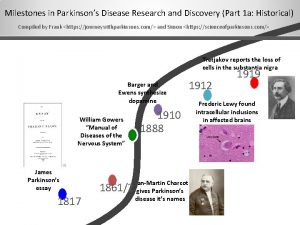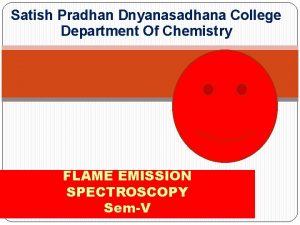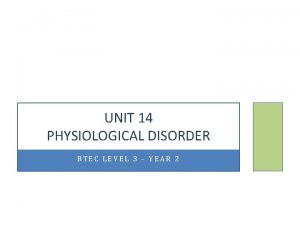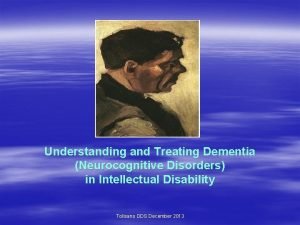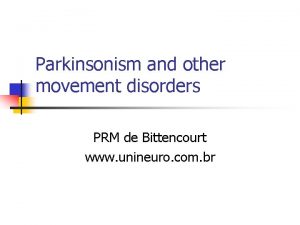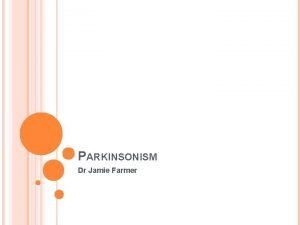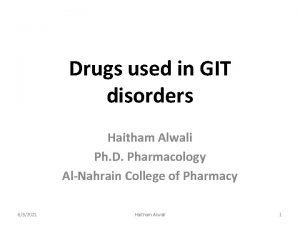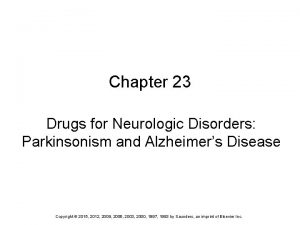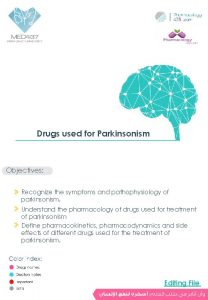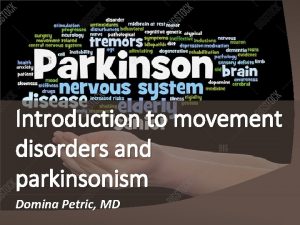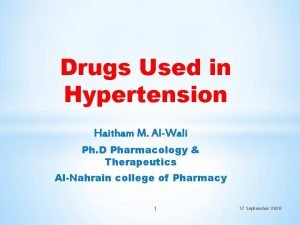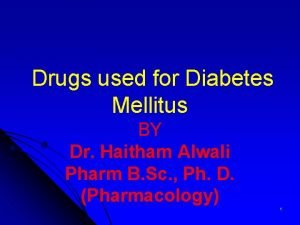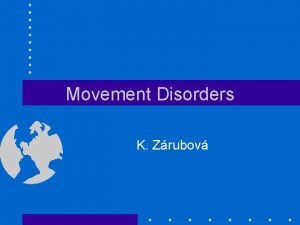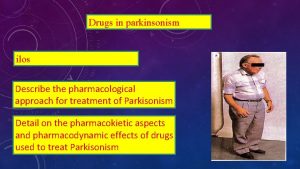Drugs Used in Parkinsonism Other Movement Disorders Haitham




















- Slides: 20

Drugs Used in Parkinsonism & Other Movement Disorders Haitham M. Kadhim Ph. D. Pharmacology FACULTY OF MEDICINE UNIVERSITY OF AL-NAHRAIN 1 15 September 2020

Drugs Used in Parkinsonism & Other Movement Disorders: Introduction • Movement disorders constitute a number of heterogeneous neurologic conditions with very different therapies. • They include parkinsonism, Huntington's disease, Wilson's disease, and Gilles de la Tourette's syndrome. • Movement disorders, including athetosis, chorea, dyskinesia, dystonia, tics, and tremor, can be caused by a variety of general medical conditions, neurologic dysfunction, and drugs. 2 15 September 2020

3 15 September 2020

Parkinsonism Pathophysiology • Parkinsonism (paralysis agitans) is a common movement disorder that involves dysfunction in the basal ganglia and associated brain structures. Signs include rigidity of skeletal muscles, akinesia (or bradykinesia), flat facies, and tremor at rest 4 15 September 2020

Naturally Occurring Parkinsonism • It is of uncertain origin and incidence from the fifth or sixth decade of life onward. • Pathologic characteristics include a decrease in the levels of striatal dopamine and the degeneration of dopaminergic neurons in the nigrostriatal tract that normally inhibit the activity of striatal GABAergic neurons on D 2 receptors. • leads to excessive excitatory actions of cholinergic neurons on striatal GABAergic neurons; thus, dopamine and acetylcholine activities are out of balance in parkinsonism 5 15 September 2020

Drug-Induced Parkinsonism Many drugs can cause parkinsonian symptoms(reversible). 1. butyrophenone and phenothiazine antipsychotic drugs, which block brain dopamine receptors. 2. At high doses, reserpine causes similar symptoms, by depleting brain dopamine. 3. MPTP (1 -methyl-4 -phenyl-1, 2, 3, 6 tetrahydropyridine), meperidine analog, causes irreversible parkinsonism through destruction of dopaminergic neurons in the nigrostriatal tract. Treatment with type B monoamine oxidase inhibitors (MAOIs) protects against MPTP neurotoxicity in animals. 15 September 2020 6 •

Drug Therapy of Parkinsonism • Strategies of drug treatment of parkinsonism involve increasing dopamine activity in the brain, decreasing muscarinic cholinergic activity in the brain, or both. • Although several dopamine receptor subtypes are present in the substantia nigra, the benefits of most antiparkinson drugs appear to depend on activation of the D 2 receptor subtype. 7 15 September 2020

Drug Therapy of Parkinsonism Levodopa Mechanisms Because dopamine has low bioavailability and does not readily cross the blood-brain barrier, its precursor, L-dopa (levodopa), is used. This amino acid enters the brain via an L-amino acid transporter (LAT) and is converted to dopamine by the enzyme (dopa decarboxylase). 8 15 September 2020

Drug Therapy of Parkinsonism Levodopa is usually given with carbidopa, a drug that does not cross the blood-brain barrier but inhibits dopa decarboxylase in peripheral tissues. With this combination, the plasma halflife is prolonged, lower doses of levodopa are effective, and there are fewer peripheral side effects. 9 15 September 2020

10 15 September 2020

Levodopa • Pharmacologic Effects • Levodopa ameliorates the signs of parkinsonism, particularly bradykinesia; moreover, the mortality rate is decreased. However, the drug does not cure parkinsonism, and responsiveness fluctuates and gradually decreases with time, which may reflect progression of the disease. 11 15 September 2020

Toxicity Levodopa 1. GIT effects include anorexia, nausea, and emesis and can be reduced by taking the drug in divided doses 2. Postural hypotension is common. Other cardiac effects include tachycardia and cardiac arrhythmias (rare). 3. Dyskinesias occur in up to 80% of patients, with choreoathetosis of the face and distal extremities. Some patients may exhibit chorea, ballismus, myoclonus, tics, and tremor. 4. Behavioral effects may include anxiety, agitation, confusion, delusions, hallucinations, and depression. Levodopa is contraindicated in patients with a history of psychosis. 12 15 September 2020

B)Dopamine Agonists 1 -Bromocriptine An ergot alkaloid, bromocriptine acts as a partial agonist at dopamine D 2 receptors in the brain. Bromocriptine used as an individual drug, in combinations with levodopa (and with anticholinergic drugs), and in patients who are refractory to or cannot tolerate levodopa. Common adverse effects include anorexia, nausea and vomiting, dyskinesias, and postural hypotension. Behavioral effects, which occur more commonly with bromocriptine than with newer dopamine agonists, include confusion, hallucinations, and 15 September 2020 13 delusions.

B)Dopamine Agonists 2 - Pramipexole This non-ergot has high affinity for D 3 receptor. effective as monotherapy in mild parkinsonism and can be used with levodopa in more advanced disease. Adverse effects include, postural hypotension, and dyskinesias. Mental disturbances (confusion, delusions, hallucinations, impulsivity) are more common than with levodopa. Contraindicated in patients with active peptic ulcer disease, psychotic illness, or recent myocardial infarction. Pramipexole neuroprotective act as a scavenger for hydrogen peroxide. 14 15 September 2020

3 - Ropinirole this drug has high affinity for the dopamine D 2 receptor. It is effective as monotherapy and can be used with levodopa to smooth out response fluctuations. Adverse effects and contraindications are similar to those of pramipexole. A related dopamine agonist, rotigotine, which is delivered via skin patch, was recently withdrawn because of crystal formation affecting its availability and efficacy. 15 15 September 2020

4 -Apomorphine A potent dopamine receptor agonist, apomorphine injected subcutaneously may provide rapid (within 10 min) but temporary relief (1– 2 h) of "off-periods" of akinesia in patients on optimized dopaminergic therapy. Because of severe nausea, pretreatment for 3 days with antiemetics (eg, trimethobenzamide) is necessary. 16 15 September 2020

Monoamine Oxidase Inhibitors Mechanism Selegine and rasagilene are selective inhibitors of monoamine oxidase type B, the form of the enzyme that metabolizes dopamine. Hepatic metabolism of selegiline results in the formation of desmethylselegiline (possibly neuroprotective) and amphetamine. Clinical Use Selegiline has minimal efficacy in parkinsonism if given alone, but can be used adjunctively with levodopa. Rasagiline is more potent and has been used as monotherapy in early symptomatic parkinsonism as well as in combinations with levodopa. 17 15 September 2020

Catechol-O-Methyltransferase (COMT) Inhibitors Mechanism of Action Entacapone and tolcapone are inhibitors of COMT, the enzyme in both the CNS and peripheral tissues that converts levodopa to 3 -O-methyldopa (3 OMD). Increased plasma levels of 3 OMD are associated poor response to levodopa. Clinical Uses The drugs are used individually as adjuncts to levodopa-carbidopa, decreasing fluctuations, improving response 18 15 September 2020

Amantadine Mechanism of Action Amantadine enhances dopaminergic neurotransmission by unknown mechanisms that may involve increasing synthesis or release of dopamine or inhibition of dopamine reuptake. The drug also has muscarinic blocking actions. Pharmacologic Effects Amantadine may improve brady-kinesia, rigidity, and tremor but is usually effective for only a few weeks. Amantadine also has antiviral effects. 19 15 September 2020

Acetylcholine-Blocking (Antimuscarinic) Drugs Mechanism of Action The drugs (eg, benztropine, biperiden, orphenadrine) decrease the excitatory actions of cholinergic neurons on cells in the striatum by blocking muscarinic receptors. Pharmacologic Effects These drugs may improve the tremor and rigidity of parkinsonism but have little effect on bradykinesia. They are used adjunctively in parkinsonism and also alleviate the reversible extrapyramidal symptoms caused by antipsychotic drugs. 20 15 September 2020
 Haitham hassanieh
Haitham hassanieh Entacapone
Entacapone Nuplazid
Nuplazid Bipolar and other related disorders
Bipolar and other related disorders Bipolar and other related disorders
Bipolar and other related disorders Alcohol is the most commonly used drug in our society
Alcohol is the most commonly used drug in our society Chapter 15 alcohol other drugs and driving
Chapter 15 alcohol other drugs and driving Chapter 15 alcohol other drugs and driving
Chapter 15 alcohol other drugs and driving Alcohol and other drugs
Alcohol and other drugs Eva tray in labour room
Eva tray in labour room Fetal phenytoin syndrome
Fetal phenytoin syndrome Movement area
Movement area Explain axial movement
Explain axial movement Self initiated other repair
Self initiated other repair D'arsonval meter movement used with half-wave rectification
D'arsonval meter movement used with half-wave rectification The monophasic liquid dosage form is dash solution
The monophasic liquid dosage form is dash solution In a premix burner used in fes the fuel used is
In a premix burner used in fes the fuel used is In a premix burner used in fes the fuel used is
In a premix burner used in fes the fuel used is Health and social care level 3 unit 14
Health and social care level 3 unit 14 Unit 14 physiological disorders
Unit 14 physiological disorders Neurocognitive disorders
Neurocognitive disorders


